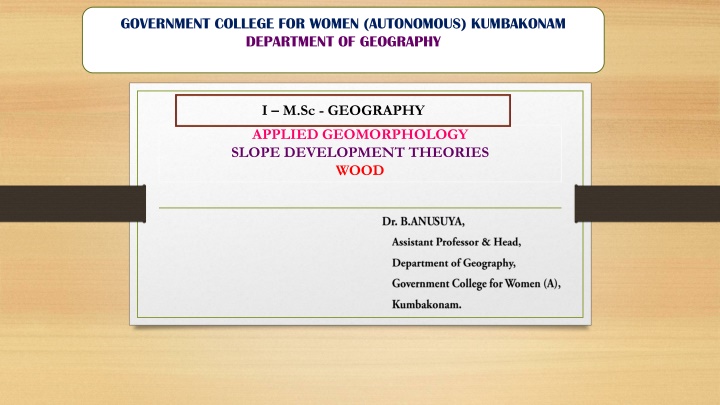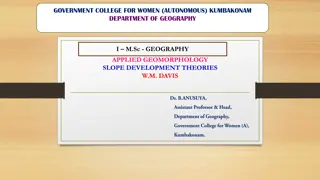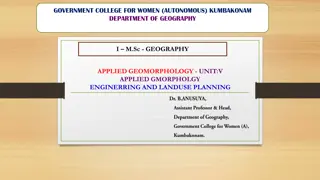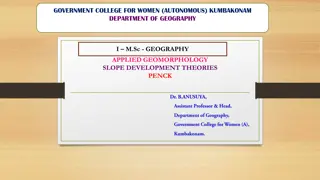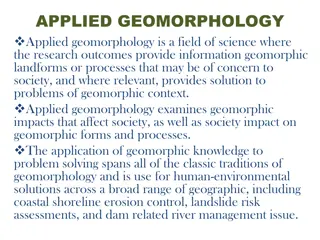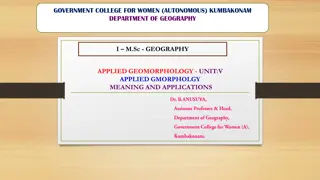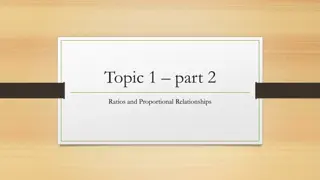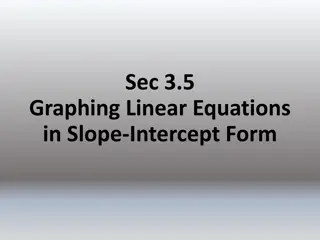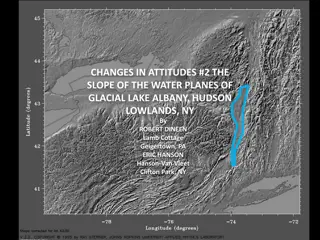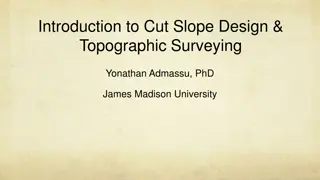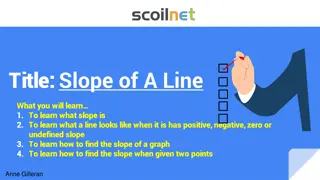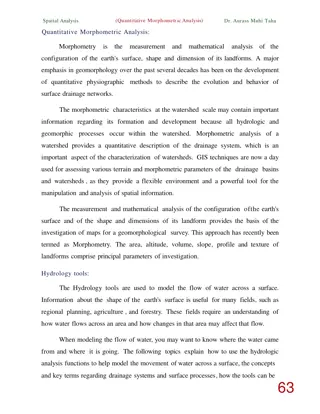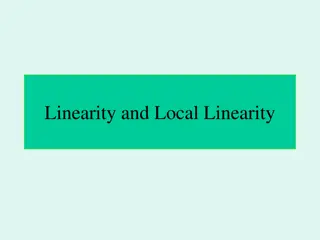Slope Development Theories in Applied Geomorphology
Slopes are formed through different processes as described by Wood's slope development theories, such as the Four Unit Slope Model and the 9-Unit Slope Model. These models illustrate various manifestations of slope profiles based on factors like rock composition and water movement. Different slope types include transport-limited slopes in California, weathering-limited slopes in arid climates like Utah, and terminology related to hillslope plan views. Understanding these theories is crucial in studying the landscape evolution and erosion processes in geography.
Download Presentation

Please find below an Image/Link to download the presentation.
The content on the website is provided AS IS for your information and personal use only. It may not be sold, licensed, or shared on other websites without obtaining consent from the author.If you encounter any issues during the download, it is possible that the publisher has removed the file from their server.
You are allowed to download the files provided on this website for personal or commercial use, subject to the condition that they are used lawfully. All files are the property of their respective owners.
The content on the website is provided AS IS for your information and personal use only. It may not be sold, licensed, or shared on other websites without obtaining consent from the author.
E N D
Presentation Transcript
GOVERNMENT COLLEGE FOR WOMEN (AUTONOMOUS) KUMBAKONAM DEPARTMENT OF GEOGRAPHY I M.Sc - GEOGRAPHY APPLIED GEOMORPHOLOGY SLOPE DEVELOPMENT THEORIES WOOD
UNIT: IV UNIT: IV APPLIED GEOMORPHOLOGY APPLIED GEOMORPHOLOGY - - P18GC101 SLOPE DEVELOPMENT THEORIES WOOD How are Slopes Formed? According to WOOD: Slope profiles can have several manifestations depending on the factors discuss above. Below are two popular examples of slope models. Four Unit Slope Model Four unit slope model (Wood, 1942) The four unit slope is best developed on a high initial (primary) slope composed of strong rock and the absence of local undercutting. As the steep fall face retreats the base is covered by a straight talus slope. . Four Unit slope model modified from Wood (1942) P18GC101
9-Unit Slope Model of Dalrymple et al, 1968 interfluve: divide area characterized by largely vertical subsurface water and soil movement seepage slope: gently dipping portion dominated by downward percolation convex creep slope: upper convex zone characterized by creep and terracette formation fall face: Cliff face characterized by rapid detachment of material or bedrock (weathering limited) exposure. transportational mid-slope: Active region characterized by mass movement, terracette formation, slope wash and subsurface water action colluvial foot slope: Depositional region. Material is further transported down slope by creep, slopewash and subsurface flow. Alluvial toe-slope: region of alluvial deposition (e.g. levee deposits) Channel wall: removal by corrasion, slumping, fall etc. Channel bed: Down stream transport of material
Transport-limited slope in the California Coastal Range underlain by poorly consolidated sedimentary rocks and melange. These slopes have a thick active regolith.
Merrimack Butte Utah. This arid climate produces weathering-limited slopes that typically lack unit 3. Merrimack Butte Utah. This arid climate produces weathering-limited slopes that typically lack unit 3.
Terminology related to the plan view of the hillslope: Slopes can be divided laterally into sections based on surface flow. Imagine drawing flowlines from the highest contour to the base of the slope. Diverging flowlines define diverging sections, parallel flowlines parallel sections, and converging flowlines converging sections. These are further outlined below: Parallel: straight section Diverging: ridge, interfluve, etc. Converging: valley, hillside depression or embayment When defining a model for a slope profile it's best to do so along a straight section.
Thank you Thank you
